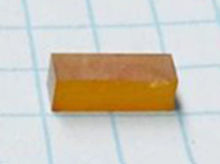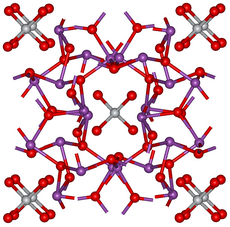Bismuth titanate
 Bi12TiO20 crystal
|
|
 Bi12TiO20 crystal structure
|
|
| Names | |
|---|---|
| Other names
Bismuth titanium oxide, dodecabismuth titanate
|
|
| Identifiers | |
|
12441-73-5 |
|
| Properties | |
| Bi12TiO20 | |
| Molar mass | 2875.62 |
| Odor | odorless |
| Density | 9.03 g/cm3 |
| Melting point | 875 °C (1,607 °F; 1,148 K) Decomposes to Bi4Ti3O12 and Bi2O3 |
| insoluble | |
| Structure | |
| body-centered cubic, cI66 | |
| I23, No. 197 | |
|
Except where otherwise noted, data are given for materials in their standard state (at 25 °C [77 °F], 100 kPa).
|
|
| Infobox references | |
|
Bi4Ti3O12 crystal structure
|
|
| Names | |
|---|---|
| Other names
Bismuth titanium oxide
|
|
| Identifiers | |
|
12010-77-4 |
|
| ChemSpider |
10637934 |
| EC Number | 234-564-6 |
| Properties | |
| Bi4Ti3O12 | |
| Molar mass | 1171.5 |
| Odor | odorless |
| Density | 7.95 g/cm3 |
| insoluble | |
| Structure | |
| Orthorhombic, oS76 | |
| Aba2, No. 41 | |
|
Except where otherwise noted, data are given for materials in their standard state (at 25 °C [77 °F], 100 kPa).
|
|
| Infobox references | |
Bismuth titanate or bismuth titanium oxide is a solid inorganic compound of bismuth, titanium and oxygen with the chemical formula of Bi12TiO20 or Bi4Ti3O12.
Bismuth titanate ceramics can be produced by heating a mixture of bismuth and titanium oxides. Bi12TiO20 forms at 730–850 °C, and melts when the temperature is raised above 875 °C, decomposing in the melt to Bi4Ti3O12 and Bi2O3. Millimeter-sized single crystals of Bi12TiO20 can be grown by the Czochralski process, from the molten phase at 880–900 °C.
Bismuth titanates exhibit electrooptical effect and photorefractive effect, that is, a reversible change in the refractive index under applied electric field or illumination, respectively. Consequently, they have potential applications in reversible recording media for real-time holography or image processing applications.
...
Wikipedia
